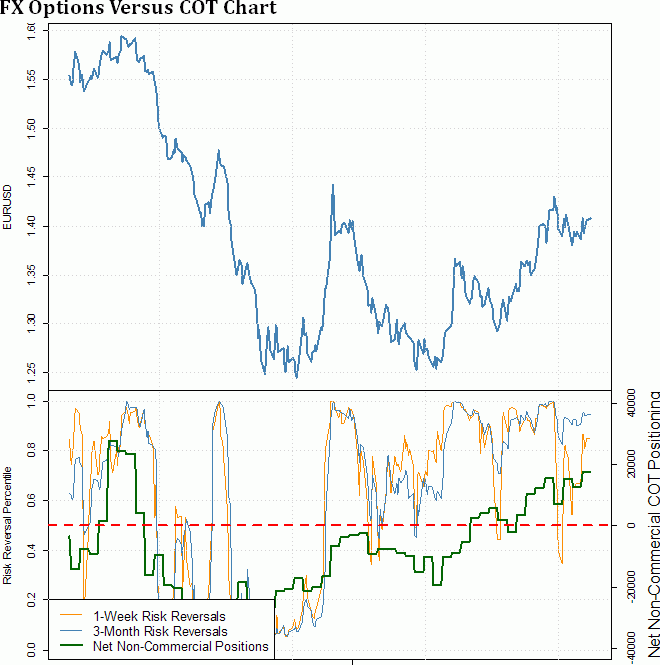Using COT Report To Forecast FX Movements (Part 2)
Post on: 2 Май, 2015 No Comment

(Reposted from Investopedia)
Cont-
Using the COT Report
In using the COT report, commercial positioning is less relevant than noncommercial positioning because the majority of commercial currency trading is done in the spot currency market, so any commercial futures positions are highly unlikely to give an accurate representation of real market positioning. Noncommercial data, on the other hand, is more reliable as it captures traders’ positions in a specific market. There are three primary premises on which to base trading with the COT data:
Flips in market positioning may be accurate trending indicators.
Extreme positioning in the currency futures market has historically been accurate in identifying important market reversals.
Changes in open interest can be used to determine strength of trend.
Flips in Market Positioning
Before looking at the chart shown in Figure 2, we should mention that in the futures market all foreign currency exchange futures use the U.S. dollar as the base currency. For Figure 2, this means that net-short open interest in the futures market for Swiss francs (CHF) shows bullish sentiment for USD/CHF. In other words, the futures market for CHF represents futures for CHF/USD, on which long and short positions will be the exact opposite of long and short positions on USD/CHF. For this reason, the axis on the left shows negative numbers above the center line and positive numbers below.
The chart below shows that trends of noncommercial futures traders tend to follow the trends very well for CHF. In fact, a study by the Federal Reserve shows that using open interest in CHF futures will allow the trader to correctly guess the direction of USD/CHF 73% of the time.
Figure 2 — Chart showing net positions of noncommercial traders in the futures for Swiss francs (corresponding axis is on the left-hand side) on the International Monetary Market (IMM) and price action of USD/CHF from Apr 2003 to May 2005 (corresponding axis is on the right-hand side). Each bar represents one week. Source: Daily FX.
Flips — where net noncommercial open-interest positions cross the zero line — offer a particularly good way to use COT data for Swiss futures. Keeping important notation conventions in mind (that is, knowing which currency in a pair is the base currency), we see that when net futures positions flip above the line, price action tends to climb and vice versa.
In Figure 2, we see that noncommercial traders flip from net long to net short Swiss francs (and long dollars) in June 2003, coinciding with a break higher in USD/CHF. The next flip occurs in Sept 2003, when noncommercial traders become net long once again. Using only this data, we could have potentially traded a 700-pip gain in four months (the buy at 1.31 and the sell at 1.38). On the chart we continue to see various buy and sell signals, represented by points at which green (buy) and red (sell) arrows cross the price line.
Even though this strategy of relying on flips clearly works well for USD/CHF, the flip may not be a perfect indicator for all currency pairs. Each currency pair has different characteristics, especially the high-yielding ones, which rarely see flips since most positioning tends to be net long for extended periods as speculators take interest-earning positions.
Extreme Positioning
Extreme positioning in the currency futures market has historically also been accurate in identifying important market reversals. As indicated in Figure 3 below, abnormally large positions in futures for GBP/USD by noncommercial traders has coincided with tops in price action. (In this example, the left axis of the chart is reversed compared to Figure 2 because the GBP is the base currency.) The reason why these extreme positions are applicable is that they are points at which there are so many speculators weighted in one direction that there is no one left to buy or sell. In the cases of extreme positions illustrated by Figure 3, every one who wants to be long is already long. As a result, exhaustion ensues and prices begin reversing.

Figure 3 — Chart showing net noncommercial positions in GBP futures on IMM (corresponding axis is on the left-hand side) and price action of GBP/USD (corresponding axis is on the right-hand side) from May 2004 to Apr 2005. Each bar represents one week. Source: Daily FX.
Changes in Open Interest
Open interest is a secondary trading tool that can be used to understand the price behavior of a particular market. The data is most useful for position traders and investors as they try to capitalize on a longer-term trend. Open interest can basically be used to gauge the overall health of a specific futures market; that is, rising and falling open interest levels help to measure the strength or weakness of a particular price trend.
For example, if a market has been in a long-lasting uptrend or downtrend with increasing levels of open interest, a leveling off or decrease in open interest can be a red flag, signaling that the trend may be nearing its end. Rising open interest generally indicates that the strength of the trend is increasing because new money or aggressive buyers are entering into the market. Declining open interest indicates that money is leaving the market and that the recent trend is running out of momentum. Trends accompanied by declining open interest and volume become suspect. Rising prices and falling open interest signals the recent trend may be nearing its end as fewer traders are participating in the rally.
The chart in Figure 4 displays open interest in the EUR/USD and price action. Notice that market trends tend to be confirmed when total open interest is on the rise. In early May 2004, we see that price action starts moving higher, and overall open interest is also on the rise. However, once open interest dipped in a later week, we saw the rally topped out. The same sort of scenario was seen in late Nov and early Dec 2004, when the EUR/USD rallied significantly on rising open interest, but once open interest leveled off and then fell, the EUR/USD began to sell off.
Figure 4 — Open interest in the EUR/USD (corresponding axis is on the left-hand side) and price action (corresponding axis on right-hand side) from Jan 2004 to May 2005. Each bar represents one week. Source: Daily FX.
Summary
One of the drawbacks of the FX spot market is the lack of volume data, but to compensate for this, many traders have turned to the futures market to gauge positioning. Every week, the CFTC publishes a Commitment of Traders report, detailing commercial and non-commercial positioning. Based upon empirical analysis, there are three different ways that futures positioning can be used to forecast price trends in the foreign-exchange spot market: flips in positioning, extreme levels and changes in open interest.














